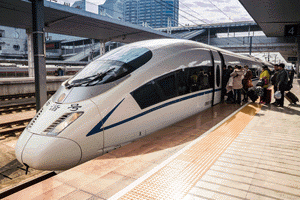
By Siah Hwee Ang*

I was in West China in the last two weeks and a few things stood out — air transport, train, commuting, and commuting at peak hours.
City to city travel
As we would expect of a big country, domestic air transport should be used most significantly on a day-to-day basis in China.
Not always so.
During the Qing Ming Jie holiday (otherwise known as Chinese Memorial Day or Tomb Sweeping Day) (4-6 April), cheaper transportation like buses and trains were sold out in an instant. Additional trains were also scheduled for the busy routes in the same period.
In China, domestic flights are considerably more expensive than trains. There are always huge delays in departure and landing. Not to mention having to be early at the airport for check-ins.
Further, the airports in China tend to be located at least 40 minutes away from the city, which means more travel time before and after flights. For my recent travel to Lanzhou, the airport is an hour and fifteen minutes from the city travelling at close to 100 km/hour in a car!
Coupled together, the experience of a train, despite being less luxurious if you are not on one of those high-speed bullet trains, is generally a less strenuous one.
For the transportation of goods, trains and trucks are often used.
Yet, local governments often levy taxes on operators. There are heavy tolls on China’s roads. In some cases, only smaller vehicles are allowed into urban areas, which means goods loaded on trucks have to be transferred to smaller vehicles for shipment.
This leads to a lot of inefficiencies in the logistical aspect of doing business in China. To the extent that e-retailers in China are building their own delivery networks to ensure that they are not caught up by this inefficiency which can hamper good customer service.
At the same time, China’s high-speed railway network (known as “gaotie”) continues to expand.
The world’s longest gaotie stretches over 2,400 kilometres from Beijing to Shenzhen, linking 28 cities.
The distance of China’s high-speed railway network surpassed those in Europe a while ago, running at 16,000 kilometres by the end of 2014. But such is the demand for these trains (which can travel between 200 to 350 km/hour) that we should expect more to be built.
The construction of high-speed railway networks has taken off in the last couple of years in West China.
We should expect more routes to be added, and to be well aligned with the Silk Road Economic Belt initiative.
Traffic within cities
Traffic within cities continues to frustrate, especially at peak hours.
My latest experience was a 25-minute snail-pace ride for 500 metres heading to my hotel. If only the infrastructure allows me to just leave my ride and walk that 500 metres.
Some of the traffic jams across China can be attributed to the number of vehicles on the road.
To this end, some cities also set up an eligibility system for what cars are allowed on the road. For example, cars not registered in Shanghai are not allowed on Shanghai streets during peak hours in the mornings and in the evenings.
This system, which somehow resembles the Hukou system of inter-city migrants, does help.
The only problem is that the continued construction of underground metro and railway trains significantly disrupts the flow on the road, leading to confusion among motorists and pedestrians.
It seems less traffic lights may be more efficient, except that in most parts of China motorists do not give way to pedestrians either.
Sounds chaotic and it is, if you see it for yourself by hanging out on the streets in some parts of China.
West China’s outlook
Chinese domestic logistical challenges have led to a country that was growing in an unbalanced way—the West region was pretty much left on its own until recently, as one can argue that little could have been done, compounded by its surroundings of mountains and deserts.
On the grand scheme of things, China is doing well despite these logistical challenges.
The internal reforms, construction of extended railway networks, and the erection of other forms of transportation and communication infrastructure, work to make West China to be more productive, and to be able to connect to East China and beyond.
While the extent of West China’s contribution to a ‘new normal’ China is unknown, it will no doubt be facilitating a lot of traffic between China and Europe. Either way, it is clear that the region is one to be watched and one to be considered for future business developments.
---------------------------------
Professor Siah Hwee Ang holds the BNZ Chair in Business in Asia at Victoria University. He writes a regular column here focused on understanding the challenges and opportunities for New Zealand in our trade with China. You can contact him here.
2 Comments
To this end, some cities also set up an eligibility system for what cars are allowed on the road. For example, cars not registered in Shanghai are not allowed on Shanghai streets during peak hours in the mornings and in the evenings.
Brilliant!
as usual rules that work for the rich (and usually government or well connected)

We welcome your comments below. If you are not already registered, please register to comment
Remember we welcome robust, respectful and insightful debate. We don't welcome abusive or defamatory comments and will de-register those repeatedly making such comments. Our current comment policy is here.